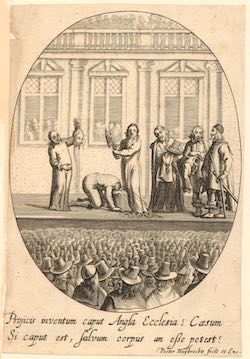Topic: 6. Sacrifices of self: Martyrology after Reformation (16th-18th Century)
During the volatile period between the sixteenth and eighteenth centuries, the concept of martyrdom underwent significant reinterpretations across different Christian denominations. This section explores how Catholics, Protestants, and Anabaptists each uniquely perceived and portrayed martyrdom. Protestants, countering the Catholic notion of sainthood, crafted new martyrologies to establish a lineage of sacrifice rooted in what they deemed as true faith. Similarly, the Anabaptists viewed the state of persecution, as chronicled in their martyrologies, as a testament to being part of the true church. This collection includes a wide array of early modern Catholic, Lutheran, Calvinist, and Anabaptist printed sources and images. It is further enriched by a comprehensive bibliography spanning from the 19th to the 21st Century, offering modern perspectives on these historical interpretations
An apologye made by the reuerende father and constante martyr of Christe Iohn Hooper late bishop of Gloceter and Worceter againste the untrue and sclaunderous report that he should be a maintainer and encorager of suche as cursed the Quenes highnes that then was, Quene Marye. Wherein thou shalte see this godlye mannes innocency and modest behauioure: and the falsehode and subtyltye of the aduersaryes of Gods truth
London: Iohn Tisdale and Thomas Hacket , 1562.
Franciscan Martyrs in England
London: Burns and Oats, 1878.
The Elizabethan Martyrs
in: The Wiley Blackwell Companion to Christian Martyrdom , pp. 322-337
Chichester: John Wiley, 2020.
The Heart of New-England Hardened Through Wickedness
London: Thomas Simmons, 1659.
Ideas of Martyrdom in Early Stuart Public Debates, 1603- 1649
Florence: PhD Dissertation, E.U.I. , 2017.
Dead Man's Treasure
in: The Production of English Renaissance Culture, pp. 190-224
Ithaca, NY: Cornell University Press, 1994.
Acts of the English Martyrs
London: Burns & Oats, 1891.
Unpublished Documents Relating to the English Martyrs
London: Catholic Record Society, 1908.
The Martyrdom of St. Barbara (1785)
Narodni Muzej Srbije, Belgrade
Adriaan von Haemstede en zijn martelaarsboek
The Hague: Boekencentrum N.V., 1970.
The Evangelistic Zeal of Reformation Geneva (1533-1560) as Exemplified in Crespin's Martyrology
in: Midwest Journal of Theology, v. 6 (2008), issue 2: pp.3-35.
Shaping Religious Communitythrough Martyr Memories
in: Mennonite Quarterly Review, v. 73 (1999), issue : pp.546-556.



